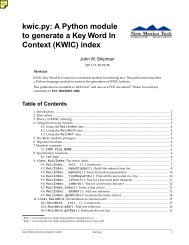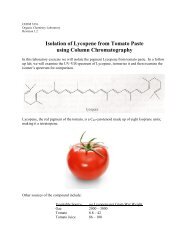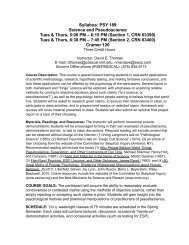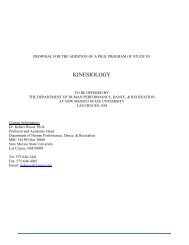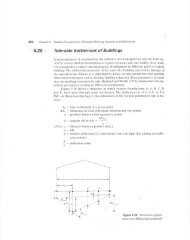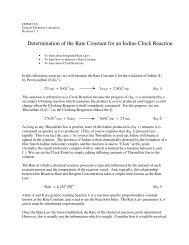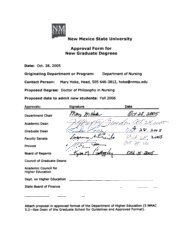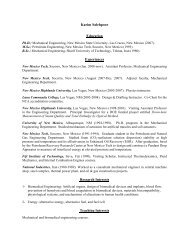The Langmuir Adsorption Isotherm
The Langmuir Adsorption Isotherm
The Langmuir Adsorption Isotherm
You also want an ePaper? Increase the reach of your titles
YUMPU automatically turns print PDFs into web optimized ePapers that Google loves.
Abstract<br />
<strong>The</strong> <strong>Langmuir</strong> <strong>Adsorption</strong> <strong>Isotherm</strong><br />
Patrick Leahy<br />
November 17, 2010<br />
Six acetic acid solutions were prepared, standardized, and allowed to adsorb onto samples of activated<br />
charcoal. <strong>The</strong> concentration of each solution was measured before and after adsorption. <strong>The</strong> adsorption<br />
constant Kads was measured to be 12.61 ± 0.911.<br />
Introduction<br />
Owing to its mostly hollow structure, even a small mass of activated charcoal presents a large surface area to<br />
adsorbants. <strong>The</strong> purpose of this experiment was to measure the adsorption of acetic acid onto that surface<br />
by allowing six solutions of varying concentration to adsorb onto samples of activated carbon of known mass.<br />
<strong>The</strong> reaction between the adsorbant A and the substrate S is<br />
and the adsorption constant Kads is<br />
Noting that [AS] = 1 − [S],<br />
Relabeling [AS] as θ and [A] as C,<br />
and hence<br />
Kads =<br />
A + S ⇀↽ AS (1)<br />
Kads = [AS]<br />
[A][S]<br />
Kads =<br />
[AS]<br />
[S] (1 − [AS])<br />
θ<br />
C (1 − θ)<br />
θ = KadsC<br />
C (1 − θ)<br />
which is the form of the <strong>Langmuir</strong> adsorption isotherm. This is equal to Y<br />
Ymax , where Ymax is the maximal<br />
adsorption. Dividing C by this yields<br />
C<br />
Y =<br />
1<br />
KadsYmax<br />
+ C<br />
Ymax<br />
A low-concentration approximation of this is the Freundlich isotherm:<br />
where k and n are empirical parameters.<br />
Y = kC 1<br />
n (5)<br />
1<br />
(2)<br />
(3)<br />
(4)
Experiment<br />
Six masses of activated charcoal were measured out, each being approximately 1.5g, and added to acetic<br />
acid solutions containing between five and one hundred percent 0.4M stock solution. <strong>The</strong> stock solution<br />
itself was titrated against potassium hydrogen phthalate (KHP) and its concentration was determined to<br />
be 0.390 ± 0.007M, and the six solutions were likewise standardized. <strong>The</strong> mass of each sample of activated<br />
charcoal and the standardized molarity of each acetic acid solution is given in the following table.<br />
Solution m(g) % 0.4M AcOH / 100mL Standardized molarity<br />
1 1.5049 100 0.0390<br />
2 1.5016 75 0.02925<br />
3 1.5062 50 0.0195<br />
4 1.5028 25 0.00975<br />
5 1.5017 10 0.00390<br />
6 1.5011 5 0.00195<br />
<strong>The</strong> six flasks were stoppered, placed in a heated shaking bath, and allowed to remain there for one week,<br />
whereafter the concentrations of the solutions in the flasks were measured again and compared to their<br />
original values. A difference was thereby obtained:<br />
Results and Discussion<br />
Solution mol AcOH (initial) mol AcOH (final) Difference (mol)<br />
1 0.0390 0.0339 0.00510<br />
2 0.02925 0.0248 0.0445<br />
3 0.0195 0.0159 0.00360<br />
4 0.00975 0.00716 0.00259<br />
5 0.00390 0.00244 0.00146<br />
6 0.00195 0.00101 0.000940<br />
From the differences in the number of moles in solution before and after absorption, the number of moles<br />
adsorbed onto the charcoal in each of the six flasks was determined; from this, the parameters necessary to<br />
describe the Freundlich and <strong>Langmuir</strong> isotherms were computed:<br />
Solution Y (mol) C (molL −1 ) C<br />
Y (L−1 ) lnC<br />
1 3.39 E-3 ± 1.63 E-5 0.339 ± 0.001 100 ± 0.564 -1.082 ± 2.95 E-3<br />
2 2.96 E-3 ± 1.32 E-5 0.248 ± 4.81 E-4 83.8 ± 0.408 -1.394 ± 1.94 E-3<br />
3 2.39 E-3 ± 1.52 E-5 0.159 ± 1.22 E-4 66.5 ± 0.426 -1.839 ± 7.67 E-4<br />
4 1.74 E-3 ± 3.30 E-5 0.0716 ± 1.87 E-3 41.6 ± 1.35 -2.637 ± 2.61 E-4<br />
5 9.72 E-4 ± 1.32 E-5 0.0244 ± 5.20 E-4 25.1 ± 0.634 -3.713 ± 0.0213<br />
6 6.26 E-4 ± 9.95 E-6 0.0101 ± 2.93 E-4 16.1 ± 0.533 -4.595 ± 0.0290<br />
as a function of C to a linear least-squares regression, by<br />
which Ymax was determined to be 0.003986 ± 2.88 E-4 mol and Kads was determined to be 12.61 ± 0.911.<br />
Similarly, by fitting Y as a function of ln(C) to a linear least-squares regression, the Freundlich parameters<br />
k and n were determined to be 0.005815 ± 3.698 E-5 and 2.079 ± 0.01552, respectively.<br />
Ymax and Kads were determined by fitting C<br />
Y<br />
2
Figure 1: <strong>The</strong> <strong>Langmuir</strong> and Freundlich isotherms plotted against the data.<br />
In general, the <strong>Langmuir</strong> isotherm is further from the data than the Freundlich isotherm.<br />
If an acetic acid molecule can be assumed to require an area A on the charcoal, then the area the charcoal<br />
offers for adsorption is AYmaxNA; hence, if A is 21 ˚A, this evaluates to 504 ± 36 m 2 g −1 .<br />
Conclusions<br />
Although the Kads derived for the <strong>Langmuir</strong> isotherm does not provide as good a fit to the data as the<br />
Freundlich isotherm (which is peculiar, since the Freundlich isotherm is an approximation), the measurment<br />
of Ymax yields a value close to the 708 m 2 g −1 of Brunauer, Emmett, and Teller [1].<br />
References<br />
[1] Brunauer, S., Emmett, P. H., and Teller, Edward. <strong>Adsorption</strong> of Gases in Multimolecular Layers. Journal<br />
of the American Chemical Society, 60, page 309 (1938).<br />
3


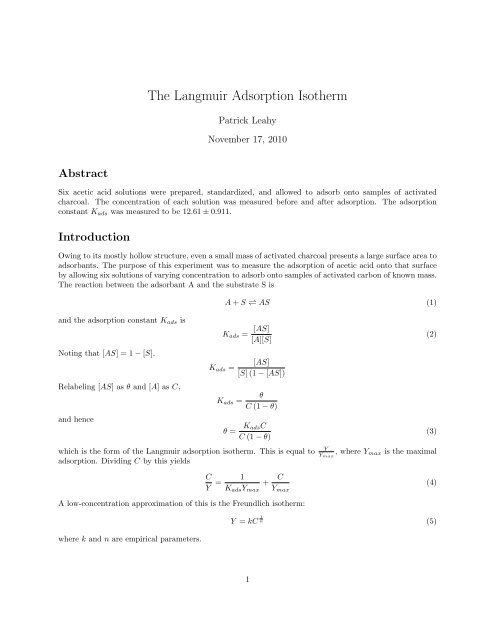
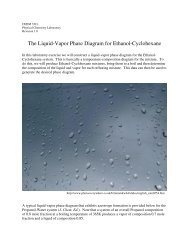
![is numerically equivalent to [0,1].](https://img.yumpu.com/21969136/1/190x245/is-numerically-equivalent-to-01.jpg?quality=85)

